

Voyager II at Waterview Condos | 2119 Lake Shore Blvd W
- Share This Page:
BUILDING DETAILS
Date Built: 2004
Builder: Monarch Group
# of Floors: 15
# of Units: 193
Pet Restrictions: Maximum 2 pets per unit (max weight 30 lbs)
Unit Size (Sq Ft): 456-1,675
Concierge Phone: (416) 255-8588
Manag't Phone: (416) 255-8731
Water, Heat, Hydro, Air Conditioning, Building Insurance, Common Elements
AVAILABLE LISTINGS IN THIS BUILDING
See Voyager II at Waterview Condos For Sale | 2119 Lake Shore Blvd W
BUILDING AMENITIES
- Indoor Swimming Pool
- Fitness Centre
- Billiard Room
- Indoor Golf Simulator
- Meeting Room, Library
- Skylounge, Party Room with Terraces
- 2 Guest Suites
- Visitor Parking
- 24 Hr Concierge
BUILDING DESCRIPTION
Discover Voyager II at Waterview condos for sale. It's a master planned community of two condominiums in the Etobicoke Waterfront by Monarch. The buildings feature a tranquil landscaped courtyard leading to an elegant two-storey lobby with a memorable water feature cascading into a reflecting pool. Lastly, they are surrounded by a promenade and boardwalk containing shops, restaurants and grocery stores to buy your everyday needs!

CONDO LOCATION
Thinking about buying or selling in this building, working with the right agent can help., are you curious about what your condo could be worth in today's market.
Just let me know your address, and I'll let you know what your condo is worth, with absolutely no obligations to sell if you're not ready to.
- Your name *
- Your email address *
- The building address *
- Your phone number *
- Is there anything else I should know?
- Comments This field is for validation purposes and should be left unchanged.
Sign Up To Receive Listing Alerts For This Building
- Your name * First Last
- Phone This field is for validation purposes and should be left unchanged.

Voyager at Waterview I
Voyager is part of Monarch’s Waterview master-planned community located on the Humber Bay waterfront in Etobicoke. The condos are easily accessible to public transportation options such as the subway, TTC, and GO Train, making it a quick ride to downtown Toronto. Residents are just steps away from the lake and the Martin Goodman Trail bike path. The buildings feature a tranquil courtyard, an elegant two-story lobby with a water feature, and a promenade and boardwalk with shops, restaurants, and a grocery store. Amenities include a 24-hour concierge, quick access elevators, a sky lounge, gym, indoor pool and hot tub, sauna, visitor parking, guest suites, party room, and car wash. Experience the best of waterfront living with views, location, and serenity in the highly desirable Voyager community. Enjoy an incredible amount of outdoor activities and dining options just steps away from the grounds.
Concierge: (416) 255-8588
Management: (416) 255-8731
Voyager at Waterview
Humber Bay Shores
Graziani + Corazza Architects
Duka Property Management
Yes + Learn More
Max two pets/unit (max 30 lbs).
Financial Statistics from Q4 of 2023
2121 Lake Shore Boulevard West
Somewhat walkable.

Maintenance Fees Cover

Floor Plans
Values & trends.
*Maintenance fees are calculated minus parking and locker.
Demographics
Data has been provided by a 3rd party supplier based on census data from Statistics Canada.
Elementary Schools
Etienne Brule Junior School
Grades: K-5
50 Cloverhill Rd, Etobicoke, ON M8Y 1T3
Fraser Rating: N/A
P: (416) 394-7850 E: [email protected]
Click here for website
St. Marks Catholic School
Grades: K-8
45 Cloverhill Rd , Etobicoke, M8Y 1T4
Fraser Rating: 6.4/10
P: 416-393-5332 E: [email protected] (Principal)
Intermediate Schools
Park Lawn Junior Middle School
71 Ballacaine Dr, Etobicoke, ON M8Y 4B6
Fraser Rating: 8.1/10
P: (416) 394-7120 E: [email protected]
Secondary Schools
Lakeshore Collegiate Institute
Grades: 9-12
350 Kipling Ave, Etobicoke, ON M8V 3L1
Fraser Rating: 4.1/10
P: (416) 394-7650 E: [email protected]
Bishop Allen Academy
721 Royal York Road Etobicoke, ON M8Y 2T3
Fraser Rating: 7.1/10
P: 416-393-5549 E: [email protected] (Principal)
Request More Info
Request a viewing.
- Date DD slash MM slash YYYY
- What unit number(s) are you interested in? *
- FAQs & Tips
- News & Press

- The Contents
- The Making of
- Where Are They Now
- Frequently Asked Questions
- Q & A with Ed Stone
golden record
Where are they now.
- frequently asked questions
- Q&A with Ed Stone
Galleries of Images Voyager Took
The Voyager 1 and 2 spacecraft explored Jupiter, Saturn, Uranus and Neptune before starting their journey toward interstellar space. Here you'll find some of those iconic images, including "The Pale Blue Dot" - famously described by Carl Sagan - and what are still the only up-close images of Uranus and Neptune.
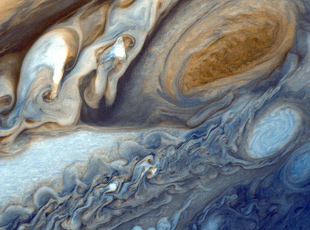
Photography of Jupiter began in January 1979, when images of the brightly banded planet already exceeded the best taken from Earth. Voyager 1 completed its Jupiter encounter in early April, after taking almost 19,000 pictures and many other scientific measurements. Voyager 2 picked up the baton in late April and its encounter continued into August. They took more than 33,000 pictures of Jupiter and its five major satellites.
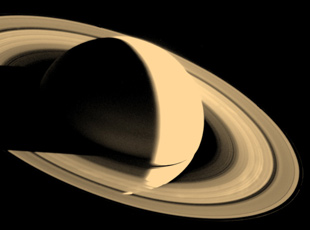
The Voyager 1 and 2 Saturn encounters occurred nine months apart, in November 1980 and August 1981. Voyager 1 is leaving the solar system. Voyager 2 completed its encounter with Uranus in January 1986 and with Neptune in August 1989, and is now also en route out of the solar system.
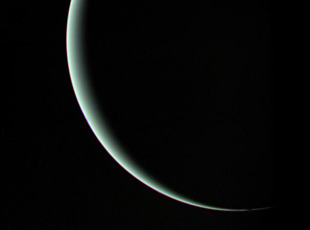
NASA's Voyager 2 spacecraft flew closely past distant Uranus, the seventh planet from the Sun, in January. At its closet, the spacecraft came within 81,800 kilometers (50,600 miles) of Uranus's cloudtops on Jan. 24, 1986. Voyager 2 radioed thousands of images and voluminous amounts of other scientific data on the planet, its moons, rings, atmosphere, interior and the magnetic environment surrounding Uranus.
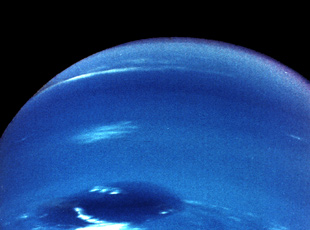
In the summer of 1989, NASA's Voyager 2 became the first spacecraft to observe the planet Neptune, its final planetary target. Passing about 4,950 kilometers (3,000 miles) above Neptune's north pole, Voyager 2 made its closest approach to any planet since leaving Earth 12 years ago. Five hours later, Voyager 2 passed about 40,000 kilometers (25,000 miles) from Neptune's largest moon, Triton, the last solid body the spacecraft will have an opportunity to study.
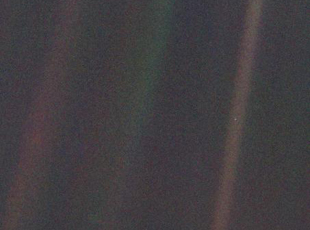
This narrow-angle color image of the Earth, dubbed 'Pale Blue Dot', is a part of the first ever 'portrait' of the solar system taken by Voyager 1. The spacecraft acquired a total of 60 frames for a mosaic of the solar system from a distance of more than 4 billion miles from Earth and about 32 degrees above the ecliptic. From Voyager's great distance Earth is a mere point of light, less than the size of a picture element even in the narrow-angle camera. Earth was a crescent only 0.12 pixel in size. Coincidentally, Earth lies right in the center of one of the scattered light rays resulting from taking the image so close to the sun. This blown-up image of the Earth was taken through three color filters -- violet, blue and green -- and recombined to produce the color image. The background features in the image are artifacts resulting from the magnification.
condominiums
Helping you make decisions that are right for you..

Voyager at Waterview
2219-2221 lake shore boulevard west, etobicoke.
- Built in 2004
- 506 units (27 floors)
Voyager at Waterview is a two tower development built in 2004 by Monarch Group. Located at 2119 and 2121 Lake Shore Boulevard West, it is comprised of a 15 and 27 floor building housing 506 units. Floor plans range from a 309 square foot studio up to two bedroom plus den offering 2,213 square feet.
The Voyager at Waterview features a long list of amenities for residents. Indoor pool, jacuzzi tub and sauna along with a well equipped fitness room. There is a lounge area, billiards, theatre and guest suites. Convenient 24-hour concierge and onsite visitor parking for guests.
Floorplan Options
1 Bedroom, 1 Bedroom Plus Den, 2 Bedroom, 2 Bedroom Plus Den, Studio/Bachelor
Party Room, Gym or Fitness Room, Patio Area, Barbecues, Billiards, Indoor Pool, Whirlpool or Hot Tub, Sauna, Guest Suite(s)
Maintenance
Common Element Maintenance and Insurance, Water, Heat, Hydro, Parking
Pricing: $380,000 to $1,870,000

Other Condo Options In Mimico

The Warehouse Lofts at Mystic Pointe - 250 Manitoba Street
Warehouse Lofts at 250 Manitoba Street is part of the Mystic Pointe community. Formerly the warehouse of the L.J McGuinness Distillers, the site was converted into hard-loft residences in 1999. $470,000 - $1,220,000

Lakeside Place - 2067 Lake Shore Boulevard West
Players Club condominiums at 2067 Lakeshore Boulevard West is a 13 floor development with 93 units. Floor plans range from 620 to 2,080 square feet and some units have oversized terraces. $440,000 - $1,650,000

Westlake Village Condos - 2200-2212-2220 Lake Shore Boulevard West
Westlake Village Condos is a three tower condominium development at 2200, 2212 and 2220 Lake Shore Boulevard West with more than 1,300 units up to 1,484 square feet. The development also includes approximately 60,000 square feet of retail space. $410,000 - $1,230,000

Skylofts II at Mystic Pointe - 200 Manitoba Street
Skylofts II at 200 Manitoba Street is part of the Mystic Pointe Development. It features 206 loft units with lots of natural light and affordable pricing. $440,000 - $790,000

Newport Beach - 2111 Lake Shore Boulevard West
Newport Beach is a community of two condominium towers and townhomes located on a prime lakefront property. 2111 Lake Shore Boulevard West offers 242 units between 664 and 4,165 square feet. $470,000 - $2,600,000

Nevis Condos - 80-88 Palace Pier Court
Built in 2003 by Monarch, Nevis Condos is a 15 and 6 floor development at 80 and 88 Palace Pier Court. It offers boutique-style lakeside living with floor plans from 526 to 1705 square feet. $430,000 - $1,175,000

Key West Condos - 36 Park Lawn Road
Key West Condos at 36 Park Lawn Road offer 421 units ranging from 499 up to 1,298 square feet in Etobicoke's Mimico neighbourhood. $450,000 - $975,000

The Waterford - 2083-2087-2095 Lake Shore Boulevard West
The Waterford Towers is a three building condominium community located at 2083, 2087 and 2095 Lakes Shore Blvd W. It has 283 total units that range from 594 up to 4,607 square feet. $440,000 - $4,500,000

Beyond the Sea South Tower - 2240 Lake Shore Boulevard West
Beyond the Sea South Tower is at 2240 Lake Shore Boulevard W in Etobicoke and is part of a three building development from Empire Communities. $500,000 - $1,350,000
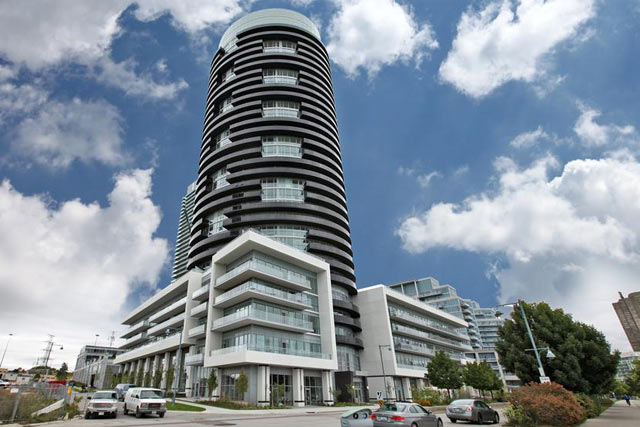
Waterscapes at Waterview - 80 Marine Parade Drive
Waterscapes at Waterview is an exclusive condominium development at 80 Marine Parade Drive. Built by Monarch, it houses 344 upscale units and a long list of amenities. $420,000 - $3,850,000

Cove at Waterways - 39 Annie Craig Drive
Cove at Waterways is a 17 floor building at 39 Annie Craig Drive, Etobicoke. It has a total of 281 units from 460 to 1,093 square feet. $420,000 - $1,240,000

Riva Del Lago - 110 Marine Parade Drive
Riva Del Lago was built in 2017 by Mattamy Homes. It offers 155 units on 16 floors ranging from 551 up to 2,649 square feet. Luxurious finishes and comprehensive list of amenities. $500,000 - $2,400,000

The Tides at Mystic Pointe - 185 Legion Road N
The Tides at Mystic Pointe is a 304 unit condominium development at 185 Legion Road N in Etobicoke. Built in 2006 by Camrost-Felcorp, it has a good range of floor plans including lofts. $405,000 - $780,000

Beyond the Sea North Tower - 15 Legion Road
Beyond the Sea North Tower is at 15 Legion Road in Etobicoke. Part of a three building development from Empire Communities, it offers units from 480 up to 1,590 square feet. $460,000 - $1,325,000

Explorer at Waterview - 58 Marine Parade Drive
Explorer at Waterview sits at 58 Marine Parade Drive with 270 units ranging from 339 up to 3,042 square feet. Luxurious waterfront living from Monarch. $380,000 - $2,600,000

South Beach Condos and Lofts - 88-90 Park Lawn Road
South Beach Condos and Lofts is an award-winning, two building development offering more than 600 units and 30,000 square feet of lifestyle amenities. $510,000 - $1,575,000

iLofts - 155 Legion Road N
iLofts at 155 Legion Road North is a 27 floor development with 254 units. It offers loft living with 17 foot ceilings in the popular Mimico area. $440,000 - $860,000

Westlake Encore - 10 Park Lawn Road
Westlake Encore is a luxury condominium building located at 10 Park Lawn Road in Etobicoke. It is the final building in the Westlake Village development and offers 529 units. $495,000 - $1,220,000

Ocean Club Waterfront Condominiums - 59-60 Annie Craig Drive
Ocean Club Waterfront Condos is a two tower development at 59 and 60 Annie Craig Drive. It is comprised of a 39 floor tower residence and a 10 floor boutique residence. $390,000 - $1,250,000

Beyond the Sea Star Tower - 2230 Lakeshore Boulevard West
Beyond the Sea Star Tower by Empire Communities is at 2230 Lakeshore Boulevard W in Etobicoke. It has 342 units and offers 20,000 square feet of recreational facilities. $470,000 - $1,650,000

Lago at the Waterfront - 56 Annie Craig Drive
Lago at the Waterfront is a 50 floor condominium tower completed by Mattamy Homes in 2017. It offers 448 units with floor plans ranging from 366 up to 1,701 square feet. $405,000 - $1,950,000

Legend at Mystic Pointe - 190 Manitoba Street
The Legend at Mystic Pointe building is located at 190 Manitoba Street. With 10 floors and 104 units between 685 and 1,830 square feet, it is part of the Mystic Pointe residential development. $440,000 - $850,000

Nautilus at Waterview - 16 Brookers Lane
Nautilus at Waterview was completed in 2012 by Monarch Group and offers 389 units on 39 floors. Floor plans range from 399 up to 1,735 square feet. $385,000 - $1,400,000
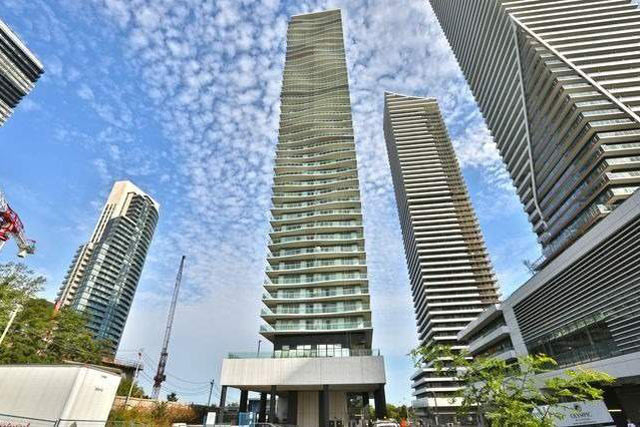
Jade Waterfront Condos - 33 Shore Breeze Drive
Jade Waterfront Condos at 33 Shore Breeze Drive in Etobicoke has 381 units that range from 464 square feet up to 1,998 square feet. $450,000 - $1,600,000

Palace Pier - 2045 Lake Shore Boulevard
Palace Pier at 2045 Lake Shore Boulevard West is a premier luxury residence with 433 spacious suites (85 of them over 3,000 square feet). Resort-like living with a full list of amenities and even an on-site restaurant and convenience store. $550,000 - $1,925,000

Grenadier Landing - 5 Marine Parade Drive
Grenadier Landing at 5 Marine Parade Drive was built in 2003 by Davies Smith Developments. With 12 floors, this boutique-style condominium offers 262 units from 642 up to 2,268 square feet. $460,000 - $1,450,000

Marina Del Rey - 2261-2267-2269 Lake Shore Boulevard West
Marina Del Rey is a three building condominium community with a total of 817 units. Located at 2261, 2267 and 2269 Lake Shore Boulevard West, it offers floor plans from 404 up to 2,525 square feet, including some two level lofts. $280,000 - $1,375,000

Grand Harbour - 2285-2287 Lake Shore Boulevard West
The iconic Grand Harbour condominiums at 2285 and 2287 Lake Shore Boulevard West were completed in 1991 by Rylar Development. Luxurious waterfront living. $400,000 - $1,850,000

You are using an outdated browser. For a better experience, keep your browser up to date. Check here for latest versions .
Read Google Reviews
Want to Talk?
Build in the early 2000s, Voyager at Waterview is comprised of two high-rise Toronto condo developments located right on the waterfront Mimico neighborhood.
Being on Lake Shore Boulevard West comes with its benefits, including having plenty of small businesses to explore at your feet and with connection to Toronto’s TTC. Spread out across 27 floors, the units at Voyager range in size from 309 to 2,213 square feet. For potential buyers, you’ll find minor differences in layout.
Building amenities include a gym and exercise room, pool, 24-hour concierge services, a party room, meeting room, guest suites, a parking garage, and even a sauna! Exclusive living is seemingly just a click away when you’re browsing condos at Voyager at Waterview.
2121 Lake Shore Blvd. West
neighbourhood
Humber Bay number of units 313
number of storeys

Our favourite feature
Your neighbours, your neighbourhood.
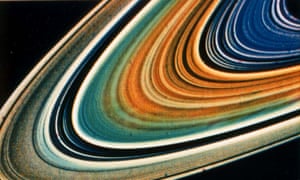
Voyager 2: the story of its mission so far – in pictures
- Share on Facebook
- Share on Twitter
- Share via Email
Since launching in 1977 , the Nasa probe has captured never-before-seen images of the solar system
- Nasa’s Voyager 2 sends back its first message from interstellar space
Mon 4 Nov 2019 17.10 GMT Last modified on Mon 4 Nov 2019 23.12 GMT
Photograph: JPL-Caltech/Nasa
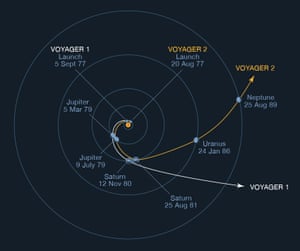
Photograph: Nasa

Photograph: JPL/Nasa
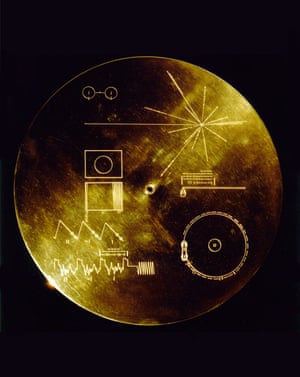
Photograph: JPL-Caltech/NASA
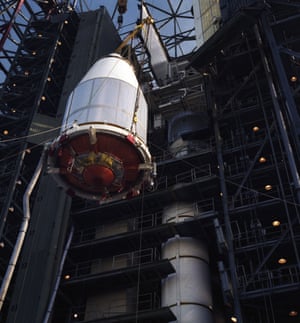
Photograph: JPL/NASA
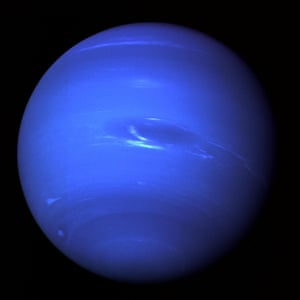
Photograph: Corbis/Getty Images
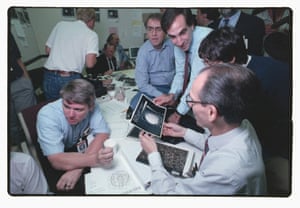
Photograph: Roger Ressmeyer/Corbis Getty Images
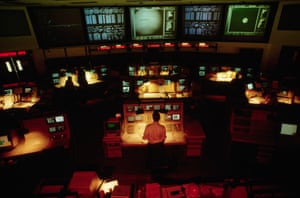
Photograph: Nasa Photo/Alamy
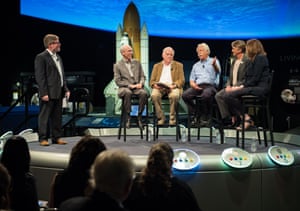
More galleries
Most popular.
Voyager Image Gallery
45 years of voyager i and ii.
Launched in 1977, NASA’s twin Voyager spacecraft inspired the world with pioneering visits to Jupiter, Saturn, Uranus, and Neptune. Their journey continues 45 years later as both probes explore interstellar space, the region outside the protective heliosphere created by our Sun. Researchers – some younger than the spacecraft – are now using Voyager data to solve mysteries of our solar system and beyond.

This archival photo shows engineers working on vibration acoustics and pyro shock testing of NASA’s Voyager on Nov. 18, 1976.

NASA’s Voyager 1 acquired this image of a volcanic explosion on Io on March 4, 1979, about 11 hours before the spacecraft’s closest approach to the moon of Jupiter.

This updated version of the iconic "Pale Blue Dot" image taken by the Voyager 1 spacecraft uses modern image-processing software and techniques to revisit the well-known Voyager view while attempting to respect the original data and intent of those who planned the images.

This illustrated graphic was made to mark Voyager 1’s entry into interstellar space in 2012. It puts solar system distances in perspective, with the scale bar in astronomical units and each set distance beyond 1 AU (the average distance between the Sun and Earth) representing 10 times the previous distance.

This graphic highlights some of the Voyager mission’s key accomplishments. Credit: NASA/JPL-Caltech Full image details

This graphic provides some of the mission’s key statistics from 2018, when NASA’s Voyager 2 probe exited the heliosphere. Credit: NASA/JPL-Caltech Full image details

First to visit all four giant planets

Voyager 2 is the only spacecraft to visit Uranus and Neptune. The probe is now in interstellar space, the region outside the heliopause, or the bubble of energetic particles and magnetic fields from the Sun.
Mission Type
What is Voyager 2?
NASA's Voyager 2 is the second spacecraft to enter interstellar space. On Dec. 10, 2018, the spacecraft joined its twin – Voyager 1 – as the only human-made objects to enter the space between the stars.
- Voyager 2 is the only spacecraft to study all four of the solar system's giant planets at close range.
- Voyager 2 discovered a 14th moon at Jupiter.
- Voyager 2 was the first human-made object to fly past Uranus.
- At Uranus, Voyager 2 discovered 10 new moons and two new rings.
- Voyager 2 was the first human-made object to fly by Neptune.
- At Neptune, Voyager 2 discovered five moons, four rings, and a "Great Dark Spot."
In Depth: Voyager 2
The two-spacecraft Voyager missions were designed to replace original plans for a “Grand Tour” of the planets that would have used four highly complex spacecraft to explore the five outer planets during the late 1970s.
NASA canceled the plan in January 1972 largely due to anticipated costs (projected at $1 billion) and instead proposed to launch only two spacecraft in 1977 to Jupiter and Saturn. The two spacecraft were designed to explore the two gas giants in more detail than the two Pioneers (Pioneers 10 and 11) that preceded them.
In 1974, mission planners proposed a mission in which, if the first Voyager was successful, the second one could be redirected to Uranus and then Neptune using gravity assist maneuvers.
Each of the two spacecraft was equipped with a slow-scan color TV camera to take images of the planets and their moons and each also carried an extensive suite of instruments to record magnetic, atmospheric, lunar, and other data about the planetary systems.
The design of the two spacecraft was based on the older Mariners, and they were known as Mariner 11 and Mariner 12 until March 7, 1977, when NASA Administrator James C. Fletcher (1919-1991) announced that they would be renamed Voyager.
Power was provided by three plutonium oxide radioisotope thermoelectric generators (RTGs) mounted at the end of a boom.
Voyager 2 at Jupiter
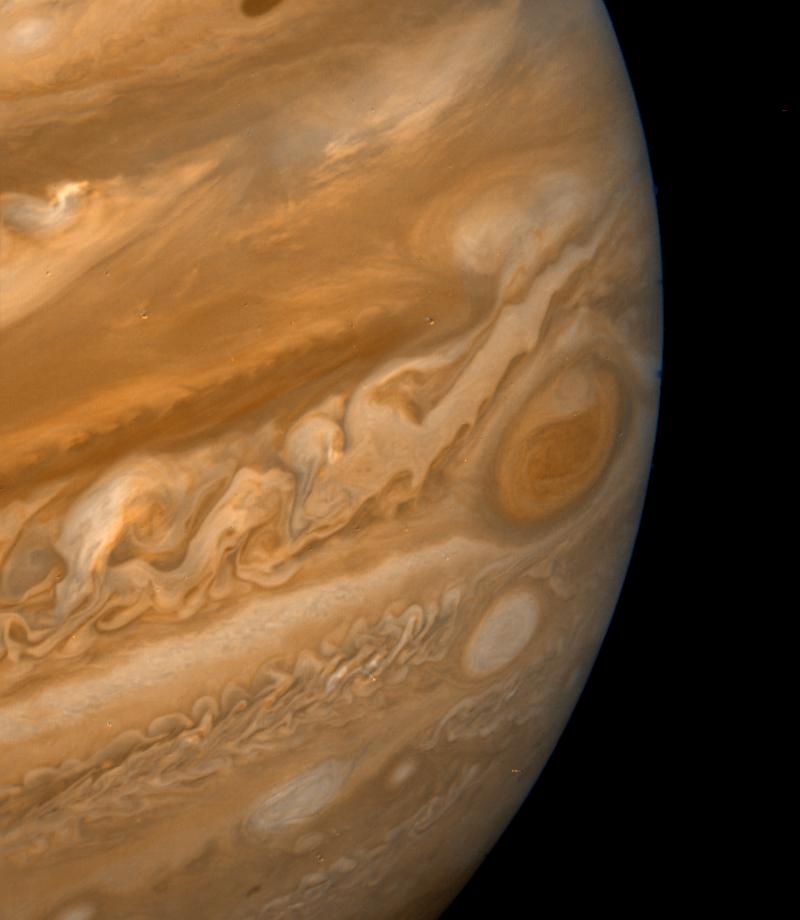
Voyager 2 began transmitting images of Jupiter April 24, 1979, for time-lapse movies of atmospheric circulation. Unlike Voyager 1, Voyager 2 made close passes to the Jovian moons on its way into the system, with scientists especially interested in more information from Europa and Io (which necessitated a 10 hour-long “volcano watch”).
During its encounter, it relayed back spectacular photos of the entire Jovian system, including its moons Callisto, Ganymede, Europa (at a range of about 127,830 miles or 205,720 kilometers, much closer than Voyager 1), Io, and Amalthea, all of which had already been surveyed by Voyager 1.
Voyager 2’s closest encounter to Jupiter was at 22:29 UT July 9, 1979, at a range of about 400,785 miles (645,000 kilometers). It transmitted new data on the planet’s clouds, its newly discovered four moons, and ring system as well as 17,000 new pictures.
When the earlier Pioneers flew by Jupiter, they detected few atmospheric changes from one encounter to the second, but Voyager 2 detected many significant changes, including a drift in the Great Red Spot as well as changes in its shape and color.
With the combined cameras of the two Voyagers, at least 80% of the surfaces of Ganymede and Callisto were mapped out to a resolution of about 3 miles (5 kilometers).
Voyager 2 at Saturn
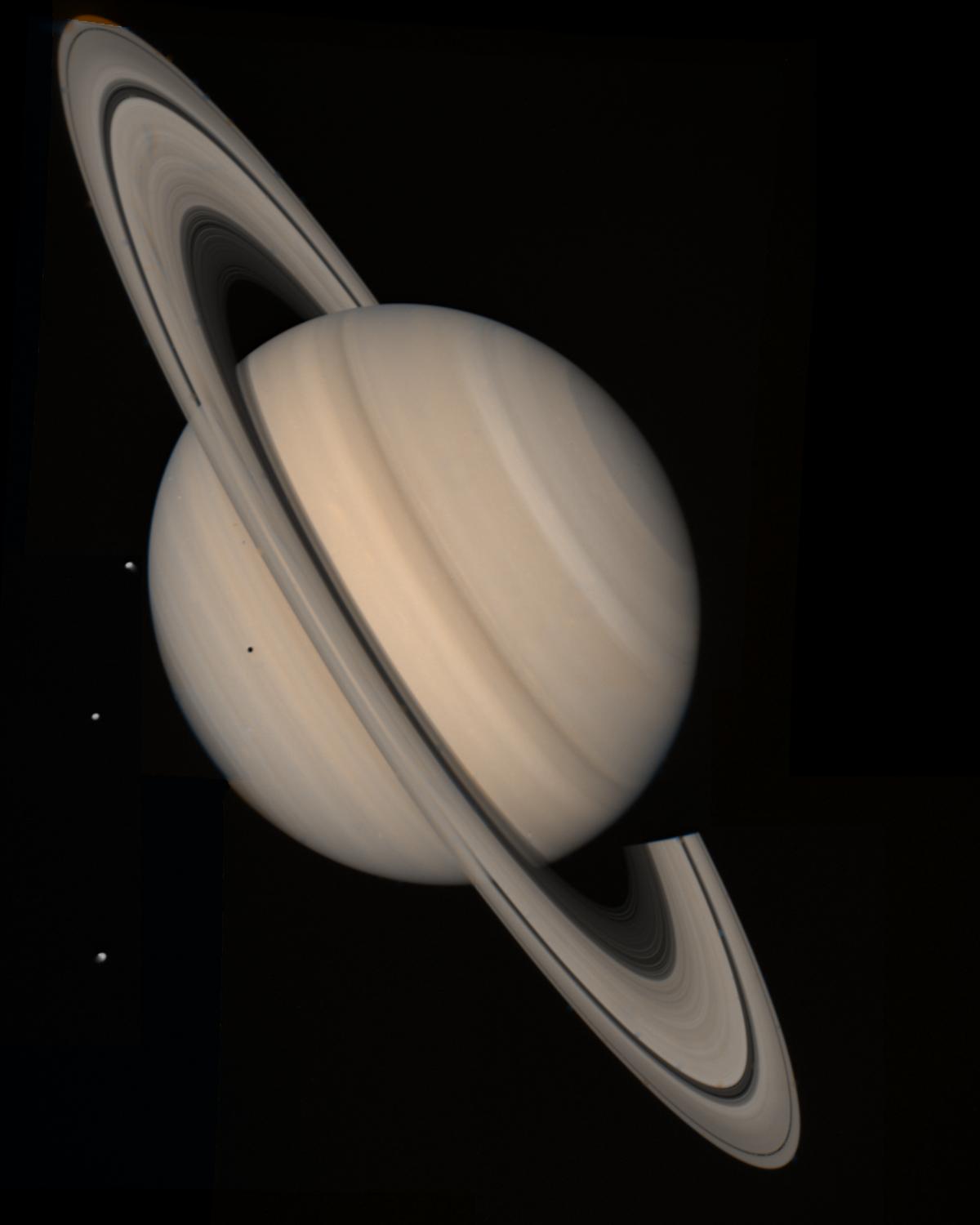
Following a course correction two hours after its closest approach to Jupiter, Voyager 2 sped to Saturn, its trajectory determined to a large degree by a decision made in January 1981, to try to send the spacecraft to Uranus and Neptune later in the decade.
Its encounter with the sixth planet began Aug. 22, 1981, two years after leaving the Jovian system, with imaging of the moon Iapetus. Once again, Voyager 2 repeated the photographic mission of its predecessor, although it actually flew about 14,290 miles (23,000 kilometers) closer to Saturn. The closest encounter to Saturn was at 01:21 UT Aug. 26, 1981, at a range of about 63,000 miles (101,000 kilometers).
The spacecraft provided more detailed images of the ring “spokes” and kinks, and also the F-ring and its shepherding moons, all found by Voyager 1. Voyager 2’s data suggested that Saturn’s A-ring was perhaps only about 980 feet (300 meters) thick.
As it flew behind and up past Saturn, the probe passed through the plane of Saturn’s rings at a speed of 8 miles per second (13 kilometers per second). For several minutes during this phase, the spacecraft was hit by thousands of micron-sized dust grains that created “puff” plasma as they were vaporized. Because the vehicle’s attitude was repeatedly shifted by the particles, attitude control jets automatically fired many times to stabilize the vehicle.
During the encounter, Voyager 2 also photographed the Saturn moons Hyperion (the “hamburger moon”), Enceladus, Tethys, and Phoebe as well as the more recently discovered Helene, Telesto and Calypso.
Voyager 2 at Uranus
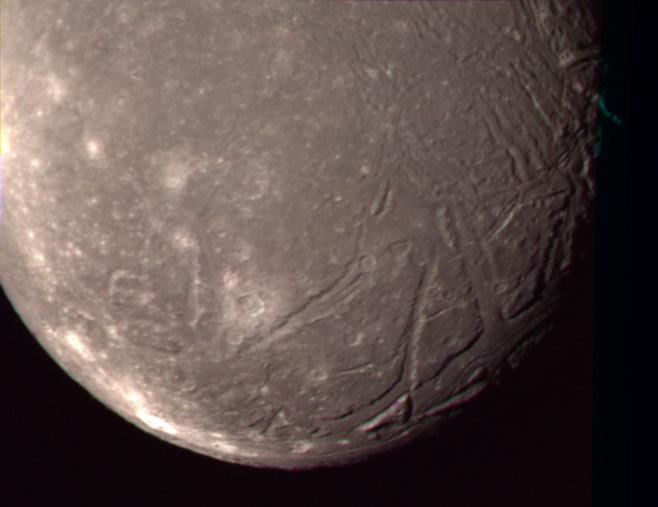
Although Voyager 2 had fulfilled its primary mission goals with the two planetary encounters, mission planners directed the veteran spacecraft to Uranus—a journey that would take about 4.5 years.
In fact, its encounter with Jupiter was optimized in part to ensure that future planetary flybys would be possible.
The Uranus encounter’s geometry was also defined by the possibility of a future encounter with Neptune: Voyager 2 had only 5.5 hours of close study during its flyby.
Voyager 2 was the first human-made object to fly past the planet Uranus.
Long-range observations of the planet began Nov. 4, 1985, when signals took approximately 2.5 hours to reach Earth. Light conditions were 400 times less than terrestrial conditions. Closest approach to Uranus took place at 17:59 UT Jan. 24, 1986, at a range of about 50,640 miles (81,500 kilometers).
During its flyby, Voyager 2 discovered 10 new moons (given such names as Puck, Portia, Juliet, Cressida, Rosalind, Belinda, Desdemona, Cordelia, Ophelia, and Bianca -- obvious allusions to Shakespeare), two new rings in addition to the “older” nine rings, and a magnetic field tilted at 55 degrees off-axis and off-center.
The spacecraft found wind speeds in Uranus’ atmosphere as high as 450 miles per hour (724 kilometers per hour) and found evidence of a boiling ocean of water some 497 miles (800 kilometers) below the top cloud surface. Its rings were found to be extremely variable in thickness and opacity.
Voyager 2 also returned spectacular photos of Miranda, Oberon, Ariel, Umbriel, and Titania, five of Uranus’ larger moons. In flying by Miranda at a range of only 17,560 miles (28,260 kilometers), the spacecraft came closest to any object so far in its nearly decade-long travels. Images of the moon showed a strange object whose surface was a mishmash of peculiar features that seemed to have no rhyme or reason. Uranus itself appeared generally featureless.
The spectacular news of the Uranus encounter was interrupted the same week by the tragic Challenger accident that killed seven astronauts during their space shuttle launch Jan. 28, 1986.
Voyager 2 at Neptune
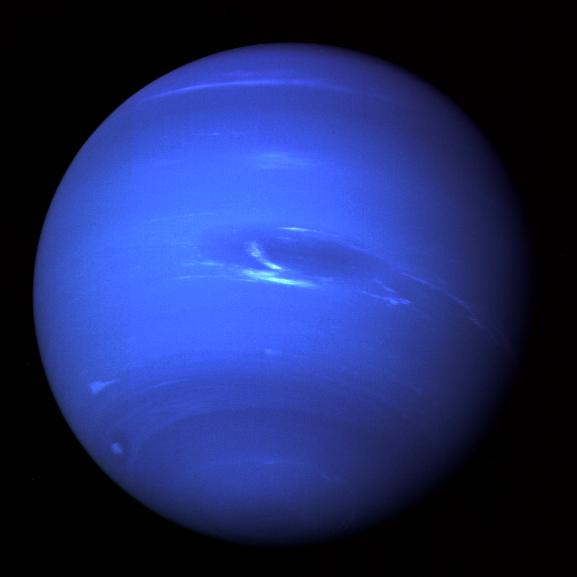
Following the Uranus encounter, the spacecraft performed a single midcourse correction Feb. 14, 1986—the largest ever made by Voyager 2—to set it on a precise course to Neptune.
Voyager 2’s encounter with Neptune capped a 4.3 billion-mile (7 billion-kilometer) journey when, on Aug. 25, 1989, at 03:56 UT, it flew about 2,980 miles (4,800 kilometers) over the cloud tops of the giant planet, the closest of its four flybys. It was the first human-made object to fly by the planet. Its 10 instruments were still in working order at the time.
During the encounter, the spacecraft discovered six new moons (Proteus, Larissa, Despina, Galatea, Thalassa, and Naiad) and four new rings.
The planet itself was found to be more active than previously believed, with 680-mile (1,100-kilometer) per hour winds. Hydrogen was found to be the most common atmospheric element, although the abundant methane gave the planet its blue appearance.
Images revealed details of the three major features in the planetary clouds—the Lesser Dark Spot, the Great Dark Spot, and Scooter.
Voyager photographed two-thirds of Neptune’s largest moon Triton, revealing the coldest known planetary body in the solar system and a nitrogen ice “volcano” on its surface. Spectacular images of its southern hemisphere showed a strange, pitted cantaloupe-type terrain.
The flyby of Neptune concluded Voyager 2’s planetary encounters, which spanned an amazing 12 years in deep space, virtually accomplishing the originally planned “Grand Tour” of the solar system, at least in terms of targets reached if not in science accomplished.
Voyager 2's Interstellar Mission
Once past the Neptune system, Voyager 2 followed a course below the ecliptic plane and out of the solar system. Approximately 35 million miles (56 million kilometers) past the encounter, Voyager 2’s instruments were put in low power mode to conserve energy.
After the Neptune encounter, NASA formally renamed the entire project the Voyager Interstellar Mission (VIM).
Of the four spacecraft sent out to beyond the environs of the solar system in the 1970s, three of them -- Voyagers 1 and 2 and Pioneer 11 -- were all heading in the direction of the solar apex, i.e., the apparent direction of the Sun’s travel in the Milky Way galaxy, and thus would be expected to reach the heliopause earlier than Pioneer 10 which was headed in the direction of the heliospheric tail.
In November 1998, 21 years after launch, nonessential instruments were permanently turned off, leaving seven instruments still operating.
At 9.6 miles per second (15.4 kilometers per second) relative to the Sun, it will take about 19,390 years for Voyager 2 to traverse a single light year.

Asif Siddiqi
Beyond Earth: A Chronicle of Deep Space Exploration
Through the turn of the century, NASA's Jet Propulsion Laboratory (JPL) continued to receive ultraviolet and particle fields data. For example, on Jan. 12, 2001, an immense shock wave that had blasted out of the outer heliosphere on July 14, 2000, finally reached Voyager 2. During its six-month journey, the shock wave had plowed through the solar wind, sweeping up and accelerating charged particles. The spacecraft provided important information on high-energy shock-energized ions.
On Aug. 30, 2007, Voyager 2 passed the termination shock and then entered the heliosheath. By Nov. 5, 2017, the spacecraft was 116.167 AU (about 10.8 billion miles or about 17.378 billion kilometers) from Earth, moving at a velocity of 9.6 miles per second (15.4 kilometers per second) relative to the Sun, heading in the direction of the constellation Telescopium. At this velocity, it would take about 19,390 years to traverse a single light-year.
On July 8, 2019, Voyager 2 successfully fired up its trajectory correction maneuver thrusters and will be using them to control the pointing of the spacecraft for the foreseeable future. Voyager 2 last used those thrusters during its encounter with Neptune in 1989.
The spacecraft's aging attitude control thrusters have been experiencing degradation that required them to fire an increasing and untenable number of pulses to keep the spacecraft's antenna pointed at Earth. Voyager 1 had switched to its trajectory correction maneuver thrusters for the same reason in January 2018.
To ensure that both vintage robots continue to return the best scientific data possible from the frontiers of space, mission engineers are implementing a new plan to manage them. The plan involves making difficult choices, particularly about instruments and thrusters.

National Space Science Data Center: Voyager 2
A library of technical details and historic perspective.

A comprehensive history of missions sent to explore beyond Earth.
Discover More Topics From NASA


2121 Lake Shore Blvd W Toronto
Voyager at waterview.
Family , Luxury , Modern , Social
Located In Humber Bay Shores
Built By Monarch Group
Completed In 2004

Photo Credits: My Visual Listings
BBQs , Board Room , Concierge , Guest Suites , Gym , Hot Tub , Indoor Pool , Outdoor Terrace , Parking Garage , Party Room , Pets Allowed , Sauna , Visitor Parking
Maintenance Fees
Water, Heating, Electricity, Air Conditioning, Building Insurance are included in the maintenance fees
Voyager At Waterview Condo
Is 27 Floors High
Has 313 Units
Is Managed By Maple Ridge Community Services
Management Phone Number is (905)-507-6726
Unknown Security Phone Number
Corporation is TSCC 1643
This Condo Project Has 1 Buildings
Voyager At Waterview Condo Floorplans
No floorplan information available at the moment

2121 Lake Shore Blvd W
2000-2249 Sqft

900-999 Sqft
Full Voyager At Waterview Condo Details
- The Voyager At Waterview Condo provides sleek and contemporary inspired + designed, functional condominiums within the Etobicoke Condos area
- The condos at 2121 Lakeshore Blvd W Toronto have a wide assortment of finishes and layouts
- Stunning views of the lake from the Voyager At Waterview condo means residents get to enjoy the relaxing atmosphere offered by such a setting
- 2121 Lakeshore Blvd W combines modern upgrades and a healthy selection of amenities with a more upscale vibe
- An affordable price point and good maintenance fees at the Voyager At Waterview condo means residents from many walks of life can enjoy these Mimico condos
- 24 Hour closed circuit television monitoring throughout the Voyager At Waterview condo
- Security systems at 2121 Lakeshore Blvd W Toronto
- Resident access fobs to all Voyager At Waterview condo common element areas
- Secured parking access at 2121 Lakeshore Blvd W Toronto
- Security enterphone access to premises within the Voyager At Waterview condo
Voyager At Waterview Related News
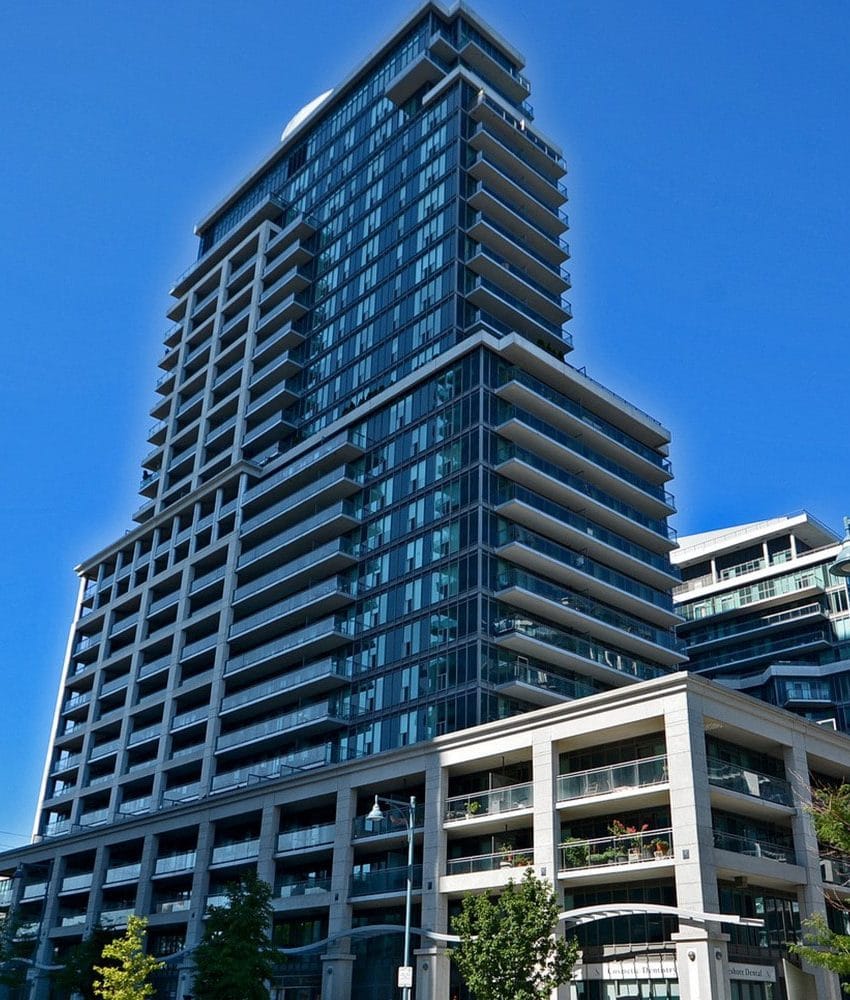
Available Units
Voyager at waterview condos reviews.

Builders typically require additional details to accept worksheet registrations. Please provide accurate information. These details are used for builder worksheet registration and are collected in accordance with our Privacy Policy .
Further Searches
Real estate has a very strong human element. aside from value appreciation, build quality and location based analysis, there is the lifestyle factor. as an example, certain real estate works better for seniors, while other locations and products are better for young professionals. our lifestyles categories allow for people to take a more human approach to finding properties..

Sign Up with IVANRE to save content to your profile. By becoming a member, you gain access to our full selection of professional real estate services.
Precon (short for preconstruction) identifies information across our portals that relates to the new development industry. precon refers to sales and projects which are currently under construction or in the planning stage. this can be a great opportunity to secure a new unit in a brand new building., no floorplans available. we're always working on adding more data..

2119 Lake Shore Boulevard W
Listing history, unit highlights, maintenance fees, unit details, nearby amenities, demographics.
Based on the dissemination area as defined by Statistics Canada. A dissemination area contains, on average, approximately 200 – 400 households.
Price Trends
Building trends at voyager ii at waterview condos, days on strata, list vs selling price, offer competition, turnover of units, property value, price ranking, rented units, best value rank, appreciation rank, rental yield, high demand, transaction insights at 2119 lake shore boulevard w, similar listings, recently viewed listings.


Suggested Searches
- Climate Change
- Expedition 64
- Mars perseverance
- SpaceX Crew-2
- International Space Station
- View All Topics A-Z
Humans in Space
Earth & climate, the solar system, the universe, aeronautics, learning resources, news & events.

NASA’s PACE Data on Ocean, Atmosphere, Climate Now Available

Altitude Chamber Gets Upgrade for Artemis II, Spacecraft Testing Begins

NASA Next-Generation Solar Sail Boom Technology Ready for Launch
- Search All NASA Missions
- A to Z List of Missions
- Upcoming Launches and Landings
- Spaceships and Rockets
- Communicating with Missions
- James Webb Space Telescope
- Hubble Space Telescope
- Why Go to Space
- Astronauts Home
- Commercial Space
- Destinations
- Living in Space
- Explore Earth Science
- Earth, Our Planet
- Earth Science in Action
- Earth Multimedia
- Earth Science Researchers
- Pluto & Dwarf Planets
- Asteroids, Comets & Meteors
- The Kuiper Belt
- The Oort Cloud
- Skywatching
- The Search for Life in the Universe
- Black Holes
- The Big Bang
- Dark Energy & Dark Matter
- Earth Science
- Planetary Science
- Astrophysics & Space Science
- The Sun & Heliophysics
- Biological & Physical Sciences
- Lunar Science
- Citizen Science
- Astromaterials
- Aeronautics Research
- Human Space Travel Research
- Science in the Air
- NASA Aircraft
- Flight Innovation
- Supersonic Flight
- Air Traffic Solutions
- Green Aviation Tech
- Drones & You
- Technology Transfer & Spinoffs
- Space Travel Technology
- Technology Living in Space
- Manufacturing and Materials
- Science Instruments
- For Kids and Students
- For Educators
- For Colleges and Universities
- For Professionals
- Science for Everyone
- Requests for Exhibits, Artifacts, or Speakers
- STEM Engagement at NASA
- NASA's Impacts
- Centers and Facilities
- Directorates
- Organizations
- People of NASA
- Internships
- Our History
- Doing Business with NASA
- Get Involved
- Aeronáutica
- Ciencias Terrestres
- Sistema Solar
- All NASA News
- Video Series on NASA+
- Newsletters
- Social Media
- Media Resources
- Upcoming Launches & Landings
- Virtual Events
- Sounds and Ringtones
- Interactives
- STEM Multimedia

The April 8 Total Solar Eclipse: Through the Eyes of NASA

NASA’s Boeing Crew Flight Test Mission Overview

Hubble Spots a Galaxy Hidden in a Dark Cloud

NASA Shares Medical Expertise with New Space Station Partners

From NASA’s First Astronaut Class to Artemis II: The Importance of Military Jet Pilot Experience

The Ocean Touches Everything: Celebrate Earth Day with NASA

Earth Day Poster 2024
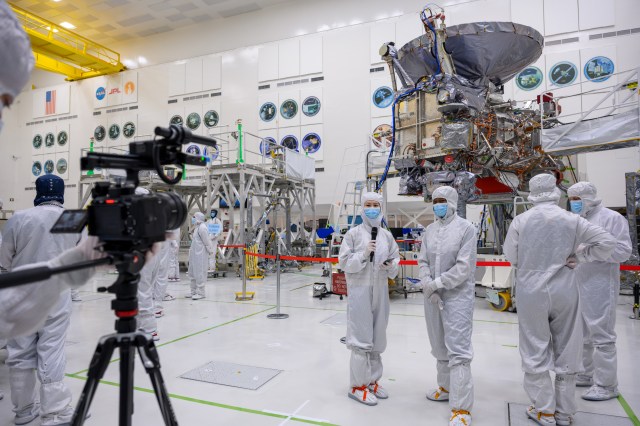
Media Get Close-Up of NASA’s Jupiter-Bound Europa Clipper

More Than 36,000 Volunteers Helped Do NASA Eclipse Science

NASA’s TESS Temporarily Pauses Science Observations

NASA Names Finalists of the Power to Explore Challenge
Earth Day 2024: Posters and Virtual Backgrounds

NASA Langley Team to Study Weather During Eclipse Using Uncrewed Vehicles

ARMD Solicitations

NASA Noise Prediction Tool Supports Users in Air Taxi Industry

Tech Today: Folding NASA Experience into an Origami Toolkit

NASA’s SERT II: ‘A Genuine Space Success Story’

NASA Partnerships Bring 2024 Total Solar Eclipse to Everyone

Shawnta M. Ball Turns Obstacles into Opportunities in Goddard’s Education Office

A Langley Intern Traveled 1,340 Miles to View a Total Solar Eclipse. Here’s What She Saw.

La presentación del X-59 de la NASA personifica la tradición aeronáutica
45 years ago: voyager 2 begins its epic journey to the outer planets and beyond, johnson space center.
Forty-five years ago, the Voyager 2 spacecraft left Earth to begin an epic journey that continues to this day. The first of a pair of spacecraft, Voyager 2 lifted off on Aug. 20, 1977. NASA’s Jet Propulsion Laboratory (JPL) in Pasadena, California, manages the spacecraft on their missions to explore the outer planets and beyond. Taking advantage of a rare planetary alignment to use the gravity of one planet to redirect the spacecraft to the next, the Voyagers initially targeted only Jupiter and Saturn, but Voyager 2 went on to explore Uranus and Neptune as well. The Voyagers carried sophisticated instruments to conduct their in-depth explorations of the outer planets. Both spacecraft continue to return data as they make their way out of our solar system and enter interstellar space.
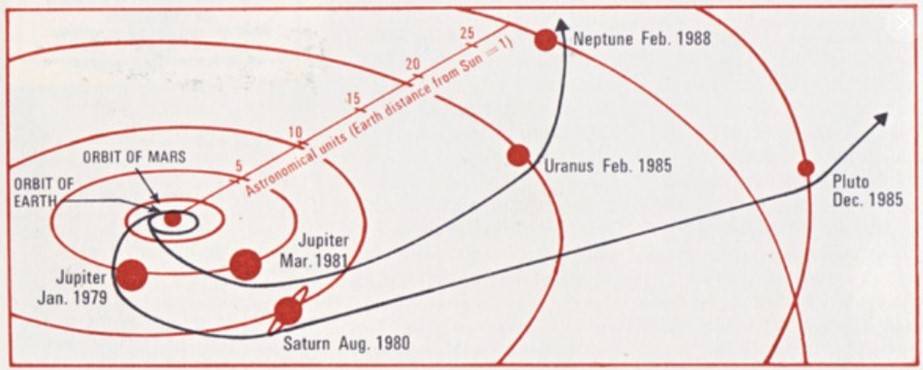
In the 1960s, mission designers at JPL noted that the next alignment of the outer planets that occurs only every 175 years would happen in the late 1970s. Technology had advanced sufficiently that spacecraft could take advantage of this rare alignment to flyby Jupiter and use its gravity to bend their trajectories to visit Saturn, and repeat the process to also visit Uranus, Neptune, and Pluto. Launching several missions to visit each planet individually would take much longer and cost much more. The original plan to send two pairs of Thermoelectric Outer Planet Spacecraft on these Grand Tours proved too costly leading to its cancellation in 1971. The next year, NASA approved a scaled-down version of the project to launch a pair of Mariner-class spacecraft in 1977 to explore just Jupiter and Saturn. On March 7, 1977, NASA Administrator James C. Fletcher announced the renaming of these Mariner Jupiter/Saturn 1977 spacecraft as Voyager 1 and 2. Scientists held out hope that one of them could ultimately visit Uranus and Neptune, thereby fulfilling most of the original Grand Tour’s objectives – Pluto would have to wait many more years for its first visit.
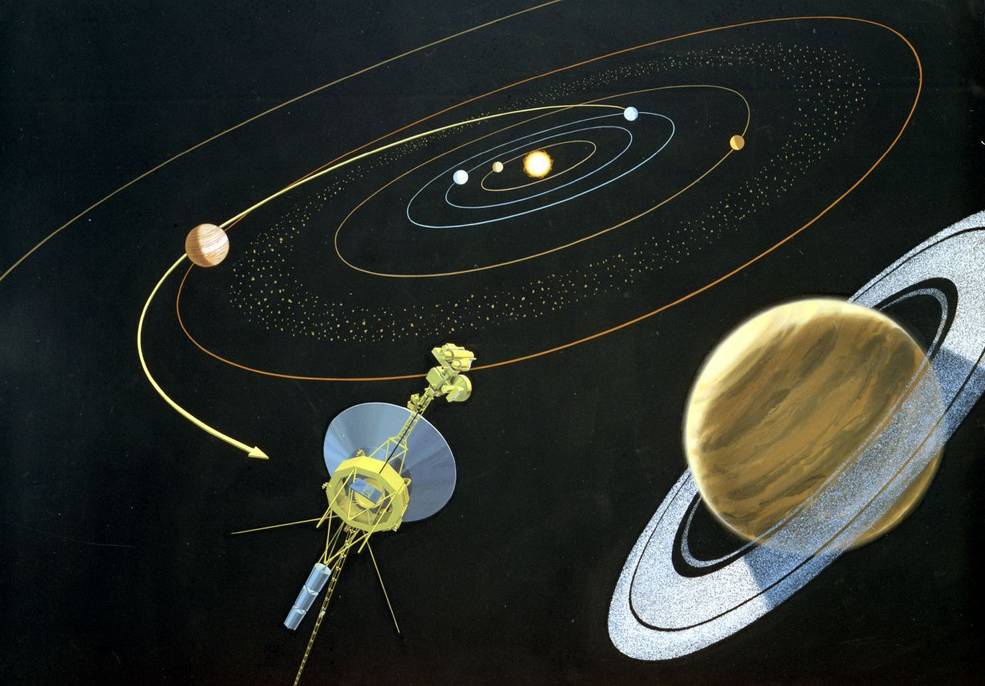
Each Voyager carried a suite of 11 instruments to study the planets during each encounter and to learn more about interplanetary space in the outer reaches of the solar system, including:
- An imaging science system consisting of narrow-angle and wide-angle cameras to photograph the planet and its satellites.
- A radio science system to determine the planet’s physical properties.
- An infrared interferometer spectrometer to investigate local and global energy balance and atmospheric composition.
- An ultraviolet spectrometer to measure atmospheric properties.
- A magnetometer to analyze the planet’s magnetic field and interaction with the solar wind.
- A plasma spectrometer to investigate microscopic properties of plasma ions.
- A low energy charged particle device to measure fluxes and distributions of ions.
- A cosmic ray detection system to determine the origin and behavior of cosmic radiation.
- A planetary radio astronomy investigation to study radio emissions from Jupiter.
- A photopolarimeter to measure the planet’s surface composition.
- A plasma wave system to study the planet’s magnetosphere.
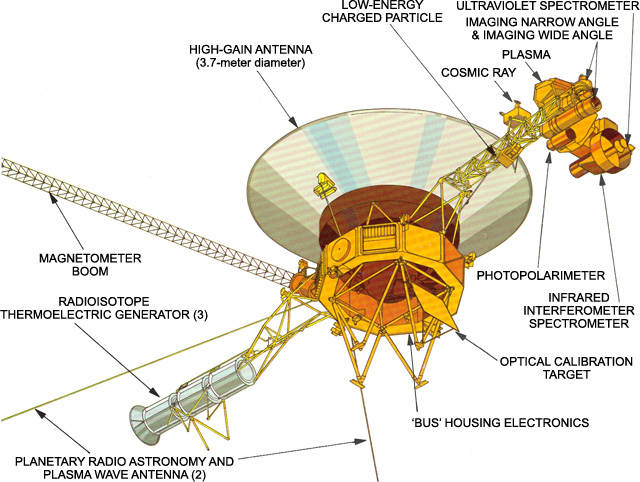
Voyager 2 left Earth first, lifting off on Aug. 20, 1977, atop a Titan IIIE-Centaur rocket from Launch Complex 41 at Cape Canaveral Air Force Station, now Cape Canaveral Space Force Station, in Florida. Although its twin launched two weeks later, it traveled on a faster trajectory and arrived at Jupiter four months earlier. Voyager 2 successfully crossed the asteroid belt between Dec. 10, 1977, and Oct. 21, 1978. In April 1978, its primary radio receiver failed, and it has been operating on its backup receiver ever since.
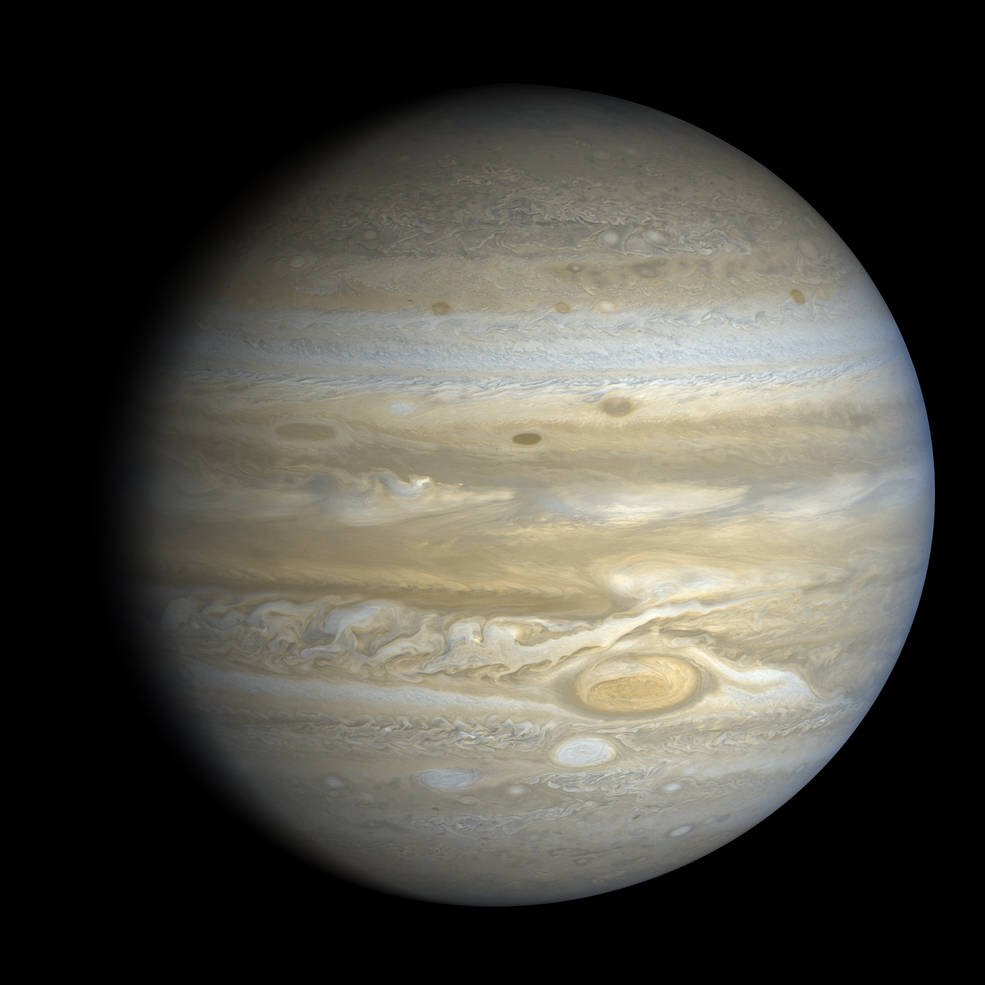
Voyager 2 conducted its observations of Jupiter between April 24 and Aug. 5, 1979, making its closest approach of 350,000 miles above the planet’s cloud tops on July 9. The spacecraft returned 17,000 images of Jupiter, many of its satellites, and confirmed Voyager 1’s discovery of a thin ring encircling the planet. Its other instruments returned information about Jupiter’s atmosphere and magnetic field. Jupiter’s massive gravity field bent the spacecraft’s trajectory, accelerating it toward Saturn. Voyager 2 began its long-range observations of the ringed planet on June 5, 1981, passed within 26,000 miles of the planet’s cloud tops on Aug. 26, and concluded its studies on Sept. 4. The spacecraft captured 16,000 photographs of the planet, its rings, and many of its known satellites. It discovered several new ones, while its instruments returned data about Saturn’s atmosphere. Saturn’s gravity sent Voyager 2 on to Uranus.
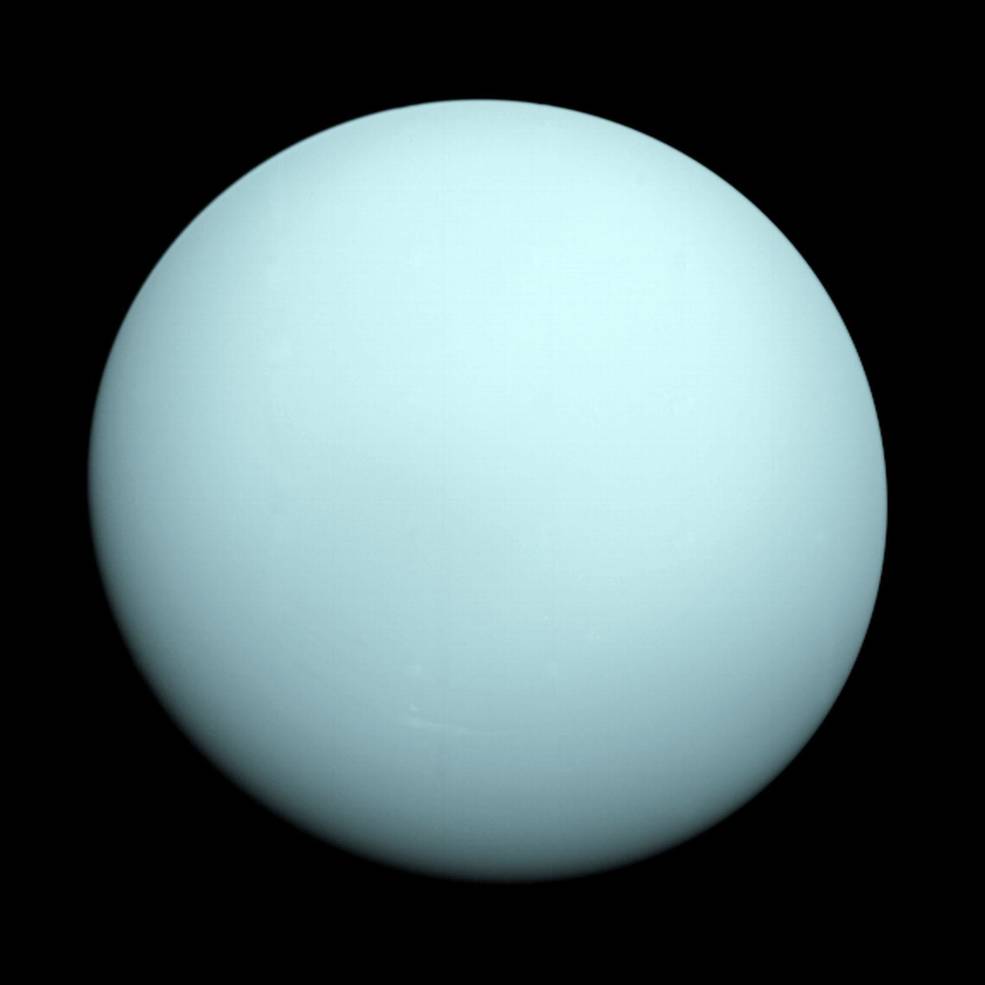
Voyager 2 carried out the first close-up observations of Uranus between Nov. 4, 1985, and Feb. 25, 1986, making its closest approach of 50,700 miles above the planet’s cloud tops on Jan. 24. It returned more than 7,000 photographs of the planet, its rings and moons, discovering two new rings and 11 new moons. The spacecraft’s instruments returned data about the planet’s atmosphere and its unusual magnetic field, tilted by 59 degrees compared to its rotational axis and offset from the planet’s center by about one-third of the planet’s radius. Voyager 2 took advantage of Uranus’ gravity to send it on to its last planetary destination, Neptune. The spacecraft conducted the first close-up observations of the eighth planet between June 5 and Oct. 2, 1989, making its flyby just 3,408 miles above its north pole on Aug. 25, its closest approach to any planet since leaving Earth in 1977. This trajectory allowed Voyager 2 to observe Neptune’s large moon Triton, the last solid object it explored. During the encounter, it returned more than 9,000 images of the planet, its atmosphere, dark rings, and moons, discovering six new moons. Like Uranus, Voyager 2’s instruments revealed that Neptune has an unusual magnetic field, not only tilted 47 degrees from the planet’s axis but also significantly offset from the planet’s center.
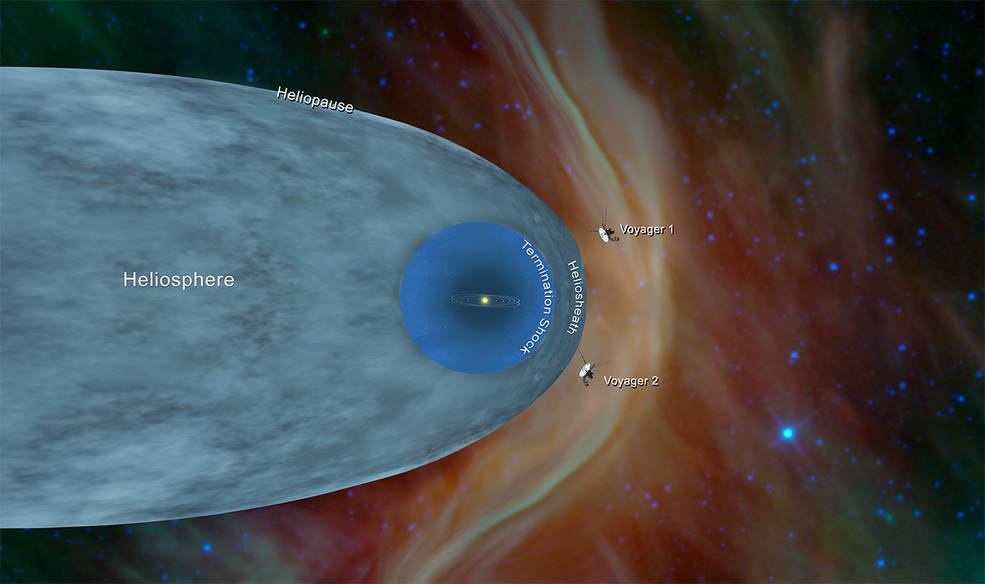
Following its reconnaissance of Neptune, Voyager 2 began its Interstellar Mission extension that continues to this day. Over the years, several of the spacecraft’s instruments have been turned off to conserve power, beginning with the imaging system in 1998, but it continues to return data about cosmic rays and the solar wind. On Nov. 5, 2018, six years after its twin, Voyager 2 crossed the heliopause, the boundary between the heliosphere – the bubble-like region of space created by the Sun – and the interstellar medium. Currently, Voyager 2 continues its mission, more than 12 billion miles from Earth, so distant that a signal from the spacecraft takes 18 hours to reach Earth, and just as long for a return signal to reach the craft. Engineers expect that Voyager 2 will continue to return data until about 2025. And just in case an alien intelligence finds it one day, Voyager 2 like its twin carries a gold-plated record that contains information about its home planet, including recordings of terrestrial sounds, music, and greetings in 55 languages. Engineers at NASA thoughtfully included Instructions on how to play the record.
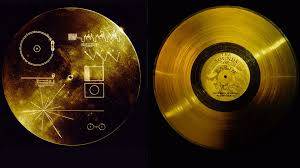
For more on Voyagers 1 and 2, NASA’s longest-lived missions, please visit here , with thanks to our colleagues at JPL.
The voyage continues…

IMAGES
VIDEO
COMMENTS
The Voyager At Waterview II Condo is located at 2119 Lake Shore Blvd W Toronto. This stunning building provides contemporary living residences in one of the ... Photo Credits: My Visual Listings. Amenities. BBQs, Board Room, Concierge, Guest Suites, Gym, Indoor Pool, Outdoor Terrace, Parking Garage, Party Room, Pets Allowed, Sauna, Visitor Parking.
The Voyager II at Waterview features freshly painted condos with various sizes and layouts. The units range in between 456 to 1700 square feet with one and two-bedroom options. Moreover, the main bedroom has a 5-piece bath and a walk-in wardrobe. Homeowners will have a sunny south facing spacious balcony with floor-to-ceiling windows.
456-1,675 sqft. Age Of Building. 19 years. Overview. Located on Lake Shore Boulevard West, Voyager II at Waterview is part of a two-tower planned community developed by Monarch Group, Canada's oldest real estate company. Standing just to the east of Voyager I, the 16-storey Voyager II building offers 194 Mimico condos for sale and for rent.
Voyager is part of Monarch's Waterview master-planned community located on the Humber Bay waterfront in Etobicoke. The condos are easily accessible to public transportation options such as the subway, TTC, and GO Train, making it a quick ride to downtown Toronto. Residents are just steps away from the lake and the Martin Goodman Trail bike path.
View photos and details for unit #903 at Voyager II at Waterview Condos. View photos and details for unit #903 at Voyager II at Waterview Condos. Skip to main. For Sale; For Rent; Sell; Blog; ... Units at Voyager II at Waterview Condos spend an average of. 41. Days on Strata. based on recent sales. List vs Selling Price. On average, these ...
Discover Voyager II at Waterview condos for sale. It's a master planned community of two condominiums in the Etobicoke Waterfront by Monarch. The buildings feature a tranquil landscaped courtyard leading to an elegant two-storey lobby with a memorable water feature cascading into a reflecting pool. Lastly, they are surrounded by a promenade and ...
Experience the best of waterfront living with views, location, and serenity in the highly desirable Voyager community. Enjoy an incredible amount of outdoor activities and dining options just steps away from the grounds. Concierge: (416) 255-8588. Management: (416) 255-8731. Complex Name.
View photos and details for unit #213 at Voyager II at Waterview Condos
Voyager II at Waterview Condos is designed by Graziani + Corazza. Development is scheduled to be completed in 2005. The project is 16 storeys tall (63.00m, 206.7ft) and has a total of 194 suites ranging from 456 sq.ft to 1,675 sq.ft. Voyager II at Waterview Condos is the # tallest condominium in and the # tallest condominium in .
This narrow-angle color image of the Earth, dubbed 'Pale Blue Dot', is a part of the first ever 'portrait' of the solar system taken by Voyager 1. The spacecraft acquired a total of 60 frames for a mosaic of the solar system from a distance of more than 4 billion miles from Earth and about 32 degrees above the ecliptic.
Voyager II at Waterview is a Condominium complex located at 2119 Lake Shore Blvd W, Etobicoke, Etobicoke, Ontario M8V 4E8, CA. The establishment is listed under condominium complex category. It has received 12 reviews with an average rating of 4.3 stars.
Voyager at Waterview is a two tower development built in 2004 by Monarch Group. Located at 2119 and 2121 Lake Shore Boulevard West, it is comprised of a 15 and 27 floor building housing 506 units. Floor plans range from a 309 square foot studio up to two bedroom plus den offering 2,213 square feet. The Voyager at Waterview features a long list ...
CALL OR TEXT US. (416) 319-6893. EMAIL US. [email protected]. Book A Meeting With Us. Build in the early 2000s, Voyager at Waterview is comprised of two high-rise Toronto condo developments located right on the waterfront Mimico neighborhood. Being on Lake Shore Boulevard West comes with its benefits, including having plenty of small ...
Waterview Condominiums Voyager I & II, Toronto, Ontario. 158 likes · 1 talking about this · 735 were here. Resident News Letter
2119 Lake Shore Boulevard West (Voyager Ii At Waterview) Voyager Ii At Waterview. 2119 Lake Shore Boulevard West, Toronto . Building. 0 units for sale ... Instant access to photos & features; Save searches & homes across devices; Enter your email address below to view property listings.
Photograph: JPL-Caltech/Nasa. This photograph of the southern hemisphere of Jupiter was obtained by Voyager 2 on 25 June 1979, at a distance of 8m miles (12m km). Seen in front of the turbulent ...
45 Years of Voyager I and II Launched in 1977, NASA's twin Voyager spacecraft inspired the world with pioneering visits to Jupiter, Saturn, Uranus, and Neptune. ... This photo of Jupiter was taken by NASA's Voyager 1 on the evening of March 1, 1979, from a distance of 2.7 million miles (4.3 million kilometers). The photo shows Jupiter's Great ...
Plots 2 to 4 are third-angle projections at 20% scale. In the SVG file, hover over a trajectory or orbit to highlight it and its associated launches and flybys. Voyager 2 is a space probe launched by NASA on August 20, 1977, to study the outer planets and interstellar space beyond the Sun's heliosphere.
Voyager 2 also returned spectacular photos of Miranda, Oberon, Ariel, Umbriel, and Titania, five of Uranus' larger moons. In flying by Miranda at a range of only 17,560 miles (28,260 kilometers), the spacecraft came closest to any object so far in its nearly decade-long travels. Images of the moon showed a strange object whose surface was a ...
Completed In 2004. The Voyager At Waterview Condo is located at 2121 Lakeshore Blvd W Toronto. This stunning building provides contemporary living residences in one of the most desirable neighbourhoods. Providing residents with extraordinary views of the lake and a contemporary, sophisticated style, 2121 Lakeshore Blvd W is a true Etobicoke ...
Several Signs Pointing to Interstellar Space. Full Resolution: TIFF (545.3 kB) JPEG (170.9 kB) 2018-12-10. Voyager Interstellar Mission. 1920x1080x3. PIA22921: Voyager 2 and the Scale of the Solar System (Artist's Concept) Full Resolution: TIFF (3.054 MB) JPEG (323.8 kB) 2023-04-26.
View photos and details for unit #601 at Voyager II at Waterview Condos. View photos and details for unit #601 at Voyager II at Waterview Condos. Skip to main. For Sale; For Rent; Sell; Blog; ... Units at Voyager II at Waterview Condos spend an average of. 41. Days on Strata. based on recent sales. List vs Selling Price. On average, these ...
Article. Forty-five years ago, the Voyager 2 spacecraft left Earth to begin an epic journey that continues to this day. The first of a pair of spacecraft, Voyager 2 lifted off on Aug. 20, 1977. NASA's Jet Propulsion Laboratory (JPL) in Pasadena, California, manages the spacecraft on their missions to explore the outer planets and beyond.